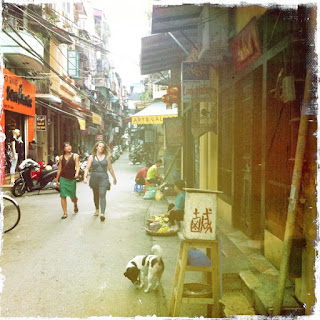McDonalds, Bangkok
iPhone Hispstamatic
Even in Bangkok, Thailand, can you not escape fast food. Ronald McDonald offers a wai as a greeting to you. A thin and rather good looking Thai girl advertises "I'm Loving It!" in the background. On average a Big Mac meal is around 130 Baht or around 4 dollars. That's significantly cheaper than what is in the USA which is more like 7 dollars. The menu is modified to fit the local sense. For breakfast, they have a thing called jook, which is like rice porridge.
Jook is not a joke.
For the most part, it was passable as far as jook is concerned. This item cost me 29 baht, or basically a dollar. The jook I'm used to has stuff that I normally wouldn't eat like liver and kidney. It's the only way I would eat that stuff. This item is probably not going to make it to the US.
Regular Thai people are in a different income range. You have some who make about 5,000 Baht a month. Essentially that equates to about 160 dollars a month in terms of earned wages. Many Thais only make about 200 baht a day. Most of the workforce therefore tends to cater to street food vendors.
Papaya Salad being made on the street.
For the most part, everyone works in Thailand. If you get fired, you open up a stall by the corner and start to cook if you got any sort of ability. Most focus on one dish. The stall above pretty much only does papaya salad. That's all they do. You walk to another vendor for noodles. Let's say you want noodles. Go to a 7/11 or Family Mart. Chances are a noodle vendor will be parked directly in front of the door. Again, not possible in the US. But then, this might be why Thailand's unemployment rate is well under 3%.
Thai Noodles in front of a Family Mart store.
There is a large variety of foods available on the streets of Bangkok. Because of the ungodly heat during the day, many Thais come out at night. In fact, this city doesn't sleep. You see Thai people sitting in front of a 7/11 store having noodles with a Leo Beer that they bought in the 7/11. No open container law here. By the way, contrary to belief, I see Thais drinking Leo more than Singha. Chang is really high on the consumption list. Here are a few more shots of some of the stalls that I saw.
How most Bangkok Thai eat.
Some street food on display.
Other options for picky visitors? Answer: The Mall. Now, the mall in Thailand is not like the mall in the USA. It is much more than just a mall. US malls lack a variety of stores. In fact, the sense of choice in a US mall is less than in Bangkok. The Food Court alone in any of the malls in Bangkok make the US malls look like the deserted mall parking lot in Back to the Future. The Food Court in Central is a good example of how behind the US is in terms of this sort of stuff. Go to Siam Square, or Paragon for a better idea. In a small local food court mall, you can get anything you like. In fact, the mall concept makes sense in Thailand. Why? The HEAT. Malls have AC! Have street food but not bake into a skewer of meat.
Fried Bananas at a mall
Pulled Pork in a Mall
If you are a tourist, or don't have a good sense of judgment about food, you can grab essentially what is street food in the mall. Now the food police in America wouldn't approve of some of the temperature monitoring and other things, but if you are paranoid about that fact, why did you go to SE Asia in the darn first place. The people eat this stuff all the time. Any yes, the Thai food is different than in the US. Like anything, it is uneven. But then, if you didn't like a meal, you only blew a dollar versus 10 buckaroos.






























